
|
|
|
Search our site
Check these out   Do you have an entertaining or useful blog or personal website? If you'd like to see it listed here, send the URL to leon@pawneerock.org. AnnouncementsGive us your Pawnee Rock news, and we'll spread the word. |
Too Long in the WindWarning: The following contains opinions and ideas. Some memories may be accurate. -- Leon Unruh. Send comments to Leon October 2007We walk with ghosts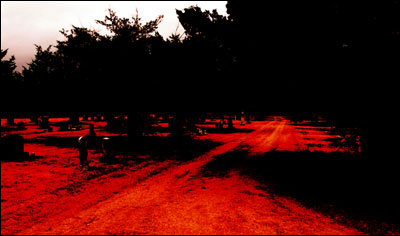
[October 31] As a boy working in the Pawnee Rock Township cemetery, I never was afraid of ghosts among the tombstones and those eerie cedar trees. I did wonder whether -- when -- I would see a ghost and what it would look like and what I would say to it. I wondered whether I would be expected to know who it was. Would it be a skeleton or would the spectre look like a revived body? In fact, I think I was more concerned about one day (or night) becoming afraid, which would ruin the cemetery for me. I always felt at home in the cemetery. In a way, we of Pawnee Rock were all at home in a cemetery. The land beneath our streets, homes, and schoolyards has long absorbed flesh and bones. Pawnee Rock sits on centuries-old battlegrounds -- the Kiowas, Pawnees, Sioux, and Santa Fe Trail wagoneers all fought and died on the Rock and in the flats where our town sits. Over the 135 years of the City of Pawnee Rock's existence, there have been other untimely deaths as well. Among them are the slaying of a wife this year in the yellow house on Rock Street, a fatal plane crash in the 1960s in the shelterbelt near Frank Schultz's house along the big ditch, a banker's suicide during the Depression, an affair that ended sadly on the Rock itself. If we were to believe in ghosts, we would have plenty of companions as we walked the streets of our town. It's hard to say whether they would be good companions; maybe they would have anger issues. But maybe they, and the souls of our other ancestors, are there to guide us. A stroll through the cemetery shows that many children were victims of the plains' hard life. As you walk at dusk, do you hear them singing in the old houses? Or is that the wind in the cedars? Have you heard the ghost on Pawnee Rock? The soul of an innocent was released late one night by a gunshot to the head, the victim of a man full of homicidal intent. The slaying happened almost 200 years ago, and the killer went on to live a long life. On a quiet night, you might stand in the street in Pawnee Rock. If you're facing the Rock, maybe you'll hear the ghost's plaintive cry: the hee-haw of Kit Carson's mule. Bill Shroeder, grocer: Leon Miller sent a note about adding a man to the chain of ownership of our longest-lasting grocery store. "I concur with Virgil Smith's recollection of Halloween in Pawnee Rock. Johnny Morris really took it upon himself to become Marshal Dillon and maintain law and order on his night of nights. "You also described the Carpenter, Hixon, Carris, American Legion building's history but one owner not mentioned was a fellow named Bill Shroeder. I believe he bought the building and business from J. D. Carpenter shortly after WWII. One of the inovations he came up with was frozen meat lockers he rented out to customers who could take a side of beef, pork or game; have it butchered and store it in the lockers until it was ready to be used. "Bill was a WWII veteran, a great friend of my dad, Cobb Miller, and also was a very active member of the American Legion. I don't know whatever became of him." Chip off the old Dracula: In the junior play, I was Count Dracula in "Boys and Ghouls Together." I'm proud to say that my "son" Buddy has picked up the torch (or maybe it's the townspeople at the door with torches). My wife dressed him up in Nik's Halloween necklace and homemade cape from a couple of years ago and gave him a set of store-bought teeth. Months of obedience class gave Buddy the wherewithal to put up with posing for her camera, and thus ve gif you Count Dogula: 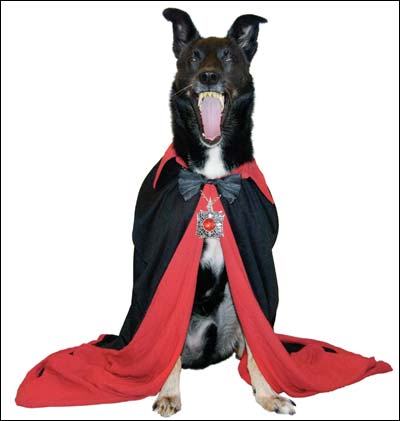 Best Jokes for (almost) All Occasions[October 30] Sometimes my wife grimaces at my humor. I've heard her tell her friends -- in that voice -- that my jokes are dry. 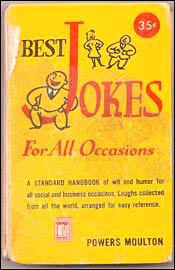 Well, I suppose that could be correct. It's what you might expect from a kid who grew up in the Great American Desert and every month or so re-read the 1942 edition of "Best Jokes for All Occasions." The blurb on the front cover says: "A standard handbook of wit and humor for all social and business occasions. Laughs collected from all the world, arranged for easy reference. By Powers Moulton." I don't know where the book came from; maybe I found it out at Grandma's, or maybe Dad or Mom had it at home after buying it at an estate sale around Pawnee Rock. I don't remember them telling any of these jokes. Maybe it's because I read the book at an impressionable age that the jokes have stuck with me for more than 30 years. For better or worse. All humor aside, the jokes kept my attention because of their cadence and phrasing, which was polite but carried a needle. The book was written during a time when English teachers were obeyed more than they are today, when Dale Carnegie was hot stuff, and when there was a war to win. I have no idea whether 1940s Americans really talked the way they're portrayed in the book (and in movies of the day), but it's easy to imagine. Maybe you spoke these jokes yourself. Maybe you have learned to just think them to yourself. The important thing is that the humor lives forever, no matter what my wife thinks. A young city girl was vacationing in the country and became friendly with a farmer boy. One evening as they were strolling across a pasture they saw a cow and calf rubbing noses in the accepted bovine fashion. "Ah," said the farmer boy, "that sight makes me want to do the same." "Well, go ahead," said the girl, "it's your cow." "Of course I'm not married," said she. "I'm nobody's fool." "Then," he said hopefully, "will you be mine?" "Some of you pedestrians walk about as if you owned the streets." "Yes, and some of you motorists drive around as though you owned your cars." The history of Halloween[October 29] I always thought of Halloween as the night when combine tires were burned in the middle of Centre Street and the school's jungle gyms were dragged downtown, as often happened in the 1960s and 1970s. Fortunately for all of us, Virgil Smith sent an e-mail to balance out the view of Halloween in Pawnee Rock: It seems that before television took over the entertainment in peoples lives, they were much more creative about filling the nonworking part of their days. Of course, pranks and practical jokes were a large part of it -- especially on Halloween and April Fool's Day. Yes, April Fool's Day was a fun time, also. At Halloween time there were some trick-or-treaters among the small set, but the emphasis was mostly on the tricks. Some tricks got so involved that the adults(?) had to take over their execution. You never knew what you might find the morning after Halloween night. One year there was a buggy on top of a tall barn. The perpetrators would have had disassemble it on the ground and pull it to the roof top, piece by piece, and reassemble it. What an accomplishment! As I remember, it stayed there for quite a while until the owner developed a plan and got the man-power to get it down. There were few indoor facilities in the rural areas, so there were many potential outhouse targets. I remember hearing about one tip-over when it was being used. Fortunately, there were no serious injuries. Most pranks were not designed to destroy or damage property, but to make a dilemma for someone. During my teen years, Johnny Morris was the town marshal. He was the husband of Stella, who ran the gas station/cafe on the east side of Centre just north of the highway. They lived in the house west of the Paul Spreier house that later became the Mennonite parsonage. Johnny seemed pretty genial, except on Halloween night. Then, he was determined that the teens should be home were they belonged and not dragging things into the street or soaping windows. One thing about Johnny that impressed me was how fast he walked. I guess that he was trying to stay in shape for his races with the teens. My wife, Joan, tells me that one Halloween she was roaming around with Bill and Bob Wycoff and other kids. They weren't doing any pranks, but were taunting Johnny. He took after them, running, and chased Joan into her house and went in right after her. That didn't please her parents and they ordered him out and defended their naughty daughter. Some years later, one of the town marshals got a police cruiser and patrolled the streets and the highway within the city limits. He started arresting motorists who were exceeding the posted speed limit on the highway and making them go to the city hall to appear before the municipal judge. They were given hefty fines and Pawnee Rock got the reputation of being a town that you didn't mess with. Also, it helped the city budget. I seem to remember a steel cell in the rear of the city hall where the fire truck was parked, but I don't think that it had been used for many years. Another activity that was popular with the teens at this time of the year, was having a watermelon party. Of course, they would wait until after dark to procure the watermelon from a patch they had staked out. The farmers seemed to expect it, but they tried to protect their crop. Answers about businesses: Virgil also answered my recent open questions about businesses in Pawnee Rock: Alice Unruh bought Lucy Houdyshell's stock and opened the dress shop next to the PO. I think that Vivian Bright was involved, either running it or buying it from Alice. Alice was Roger Unruh's sister. 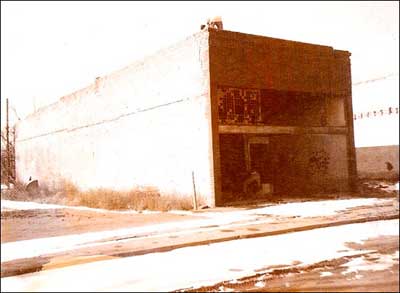
I think that the downtown, doomed brick building that you showed was the J. L. Morris (not Johnny) grocery store that was at that location in the 1940s and earlier and probably closed in the late '40s. Joan's mother clerked there for a time. I don't know if it was ever occupied after that. 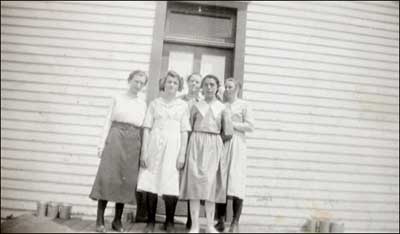
I don't know if you noticed the buckets setting on the ground by the Dist. 48 girls. These would be recycled syrup buckets. My sibs and I, as well as other kids, used them for lunch buckets. 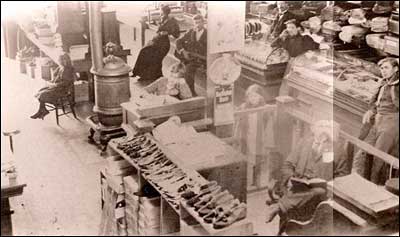
Another store, corrected: A photo I had identified (Photo Gallery page 37) as the Lindas store was really D.R. Logan's General Merchandise store, the original store in the building that later held the grocery stores owned by Carpenter, Hixon, Carris, and subsequently owned by the American Legion and Jayhawk Mechanical Services. I found a whole copy of the photo, and its legend identified it. The caption with our photo has been corrected.
The whole note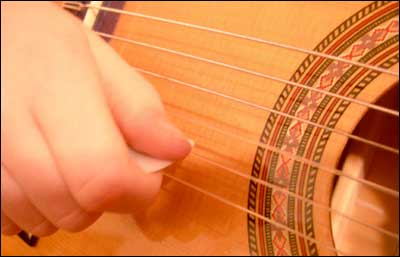
[October 28] Our son Nik has taken up the guitar. He wanted to be like country stars Brad Paisley and Rascal Flatts, but then he noticed all the sounds that an electric guitar can make and he may end up like, I don't know, Keith Richards. Nik is taking lessons from a fellow named Eddie Dorman. Our 9-year-old sits in Eddie's second-floor studio and learns about notes and melody and where to put your fingers on the frets. When Nik comes home and practices, he gets so wrapped up in following the melody and fingering that he sometimes speeds up or puts the pick back on the string before he's supposed to strum again, and that cuts the note short. In other words, a whole note sounds as short as a quarter note. I know exactly how that works. When you're at Nik's level, you feel good just being able to find the note in the first place. Aside from my other faults as a trumpet player, I tended to cut notes short too. It could have been because I don't have an especially good inner rhythm, or maybe I just got bored with the long notes and thought I'd get on to the next one. In my junior high years, I'm sure it caused my occasional accompanist, pianist Sharon Boele, a great deal of exasperation. As for my Argonne Rebels bugle instructors, Sandra Opie and Brian Pennington, there was no doubt about their exasperation; they spelled it out for me. So it was out of fear that I learned to hold the notes out. And the predictable happened -- my music got better and I enjoyed practicing so much more because the song coming out of the trumpet's bell more closely matched the "as it should be" song I was hearing between my ears. Nik will reach that point, too. I encourage him to play the song just as it's written, and one day he'll absentmindedly let the notes play out and it will occur to him that that is how the song should sound. Nik will also reach the point someday at which he learns that there's an analogy between between musical notes and the melody of life. He's going to have to learn that by himself. He'll understand then that keeping the short notes short and letting the long notes play out will help his life echo the good song he hears in his head. By then, he'll be writing his own music. And that, my music-loving friends, is the whole note. A photo I like: No. 58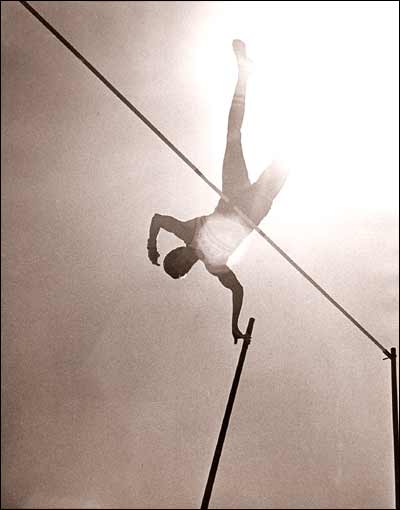
[October 27] A lot could be made of the Icarus-like image that I found in my camera after taking pictures at the Kansas Relays in Lawrence, but I don't want to go that way. Instead, I like this photo because it shows the delicate moment when all an athlete's energy -- his speed, his upper-body strength -- has been used in an effort to fling himself over a bar 17 or so feet above the ground. With a flick of his fingers to push the pole away, his attempt is complete; all that's left is to let gravity pull him down to the thick pad. To be honest, I also like the photo because my timing was lucky. I could say I got it because I learned something about timing as I spent years watching Kent Tutak, Rob Bowman, and Alan Mead pole vault at Pawnee Rock and Macksville, but this image strikes me as too elegant to be the product of diligent study. Business update No. 2[October 26] Leon Miller, our friend from Dallas whose dad ran the Mobil Oil distributorship and owned the opera house for a while, sent more information about Pawnee Rock's businesses (map): "Ann Howerton, or Annie Laurie as she went by, had her beauty/barbershop in the back of her home. I went there regularly growing up to get a haircut. As far as I know, she was the town's only barber after Lou Walker died. My uncle, Vic Miller did some barbering on the side but his main line of work was plumbing. "I don't remember Lucy Houdyshell having a 'downtown' location but always sold dresses out of her house. During the depression years my father and her would barter heating fuel for dresses for my mother and sister. "Lester, or 'Lec,' Zeiber had a nursery plot behind his house on Pawnee Avenue plus another plot east of town where he raised and sold trees and shrubs. "Before the Rock Inn, that place was known as Brazda's Cafe." Business update[October 26] Richard Batchman read today's earlier entry and sent this: "Ann's Beauty Shop was in her home on the corner of Houck and Flora street. I had my hair cut there many times when I was young." Thanks, Richard. Richard grew up two blocks north of Ann and John Howerton's place. (Ann's Beauty Shop is now on the map below.) Businesses of around 1960[October 26] As struck as I was by Neil Bowman's woodcut of the Pawnee Rock pavilion and monument (today's homepage top photo), I was even more thrilled by the list of businesses that Ruth Sessions sent with the woodcut.
I'm guessing that the woodcut and list were printed in the late 1950s or early 1960s. The Rock Inn, of course, was in the old opera house, which is now Patty Lee's antique shop. Gano Grain was in a now-removed building across from the depot's current location on Centre Street as well as south of the highway. Lucy Houdyshell's dress shop was for years in her home, but was it also in the former drugstore building west of the post office? (If it wasn't in that building, whose dress shop was that?) And did Ann Howerton have her beauty shop at home, or was it downtown? Hixon's General Store was where the American Legion was for a while; now the building is part of Dean and Greta Lakin's Jayhawk Mechanical Services empire. J.D. Carpenter previously was a grocer too. Virgil Smith, who recently wrote about his insurance and tax days, also was the mail carrier; Willard Wilson's welding shop was two doors north of the post office. Lindas Lumber was where the current firehouse is, and Elgie's Craft Shop was across the street to the south. No one ever misplaced Farmers Grain; you can see it for miles. Pawnee Garage was in the red building along the highway, next to the gas station. Cobb Miller's Socony Oil was across the highway from Farmers and a little east. But help me out -- where was the Wagon Wheel Gift and Antique shop? And where was Lester Zieber's Nursery Stock? Here's a map of Pawnee Rock businesses of the present and the past. It doesn't show everything; I'll probably need more than one map for that. If you'd like to suggest another business to put on the map, please let me know. View Larger Map Bill Beck, Linotype operator[October 25] Bill Beck was a busy man. He was born in 1915 in Pawnee Rock to William Franklin and Emma Belle Slough Beck. He was an Army captain during World War II. He was married three times and outlived all three wives. He had two daughters, a stepson, a stepdaughter, three grandchildren, six step-grandchildren, and 13 great-grandchildren.
The Tiller is where I met him. By the time I started selling pictures and words to the Tiller, the Linotypes -- those big hot-lead typesetting machines you may remember from black-and-white movies -- were replaced by the clean electronic typesetters. Newspapering was taking a new path, and Bill made sure all the machinery worked and sometimes he took a turn on the typesetting keyboard. Maybe it was because he started out in Pawnee Rock, but he took a liking to me when I showed up in 1975 as summer help. Bill was a quiet guy and always had a kind word or a smile, which by themselves were almost enough reason to show up for work. (The photo of him is one I took for the paper's Bicentennial review of Pawnee County.) There was still some lead type in the composing room; it was used on some job printing. Bill showed me how to build a stick of type, pulling the backward letters from a segmented drawer while we talked. I wasn't sharp enough to realize it, but Bill was passing on to the next generation a soon-to-be abandoned technique of printing, the way it had been done since Gutenberg. Bill died Tuesday in Larned. He was 92, but a bit of him lives on in every smile I give a kid who tries hard. (Obituary on October 24) Link fun: My friend Dr. Randy Rock -- who grew up in Pawnee Rock-sized Hope, in Dickinson County -- sent this little bit of Halloween fun: the Pumpkin Simulator. My sister, Cheryl, put this link on her FlyoverPeople site. I busted a gut last night laughing at the discussion of booklets, magazines, catalogs and comic books that we used to take more seriously. It's at The Institute of Official Cheer. (This site is for people who'be been around the block once or twice.) And speaking of Cheryl, check out her column about Grandma's quilt, which I think is one of her finest pieces of the year. There are photos of the quilt and of Grandma on FlyoverPeople. Our need to fight fires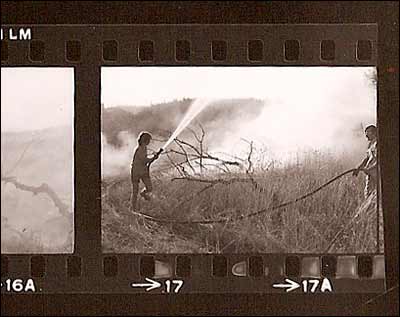
[October 24] Back in the 1960s, a high school boy from Otis or Bison was helping his town's volunteer fire department fight a grass fire out in the country. You know how impressive those fires are -- a wind-whipped blaze moves quickly and thoroughly through dried-out fields. The boy got caught up in some barbed wire -- the story is that it was a cast-off fence left in a wad -- and was swept over by the fire and killed. Our folks in Pawnee Rock talked to us about it, and for a while there was a move across Kansas to keep teenagers off firetrucks. But it being rural Kansas, sometimes people do what they have to do, and that means kids wrestle with pressurized hoses and shovels when their fields or their friend's farm is threatened. Perhaps it's ingrained in our plains souls, that need to stop the fires. We've heard all our lives about the magnificent firestorms that beset the pioneers before there were roads and plowed fields to break the fires' momentum. And, writing as a guy who used to practice on backyard leaf and grass fires with a garden hose, I can tell you that a lot of guys wanted to be on that red truck simply because it was exciting and it's what the men of Pawnee Rock did. For all my dreams and despite living next door to the fire station, my path took me into journalism. I followed the fire crews with a camera. (I tried to save the moment; they saved the township.) We all had the boy from Otis or Bison in the back of our minds. I am sure that for the rest of my years on the plains I wasn't the only one who watched the fencelines for discarded barbed wire, not the only one who made sure there was a way out of wherever I was. Most of us have seen the spring fires in the Flint Hills, where long lines of orange creep over the hills under a brown curtain; the cattle feeding at the edge of the prairie-scouring fire look as if they could simply step over the flames to safety in the ashes. I think that's how we all imagine prairie firefighting -- when we're in danger, it's a simple thing to save ourselves. But sometimes reality is more difficult. These fires come to mind, of course, because of the forest and brush fires that are tearing across southern California. I have to wonder how many boys and girls -- and their parents -- are squaring off against the flames and their fears. A missive from Leon Miller: "I enjoyed reading Virgil Smith's recollection of Chet Spreier's artifacts collection. It was priceless. Chet and Doris were our neighbors and close friends for many years and we loved them dearly. Chet developed this penchant for hypochondria and traveled far and wide seeking a cure for his imagined illnesses. "Whenever I would see him I would ask him how he was doing. Inevitably, he would say, 'I feel so bad that I could die tomorrow.' But after some time I figured out a way to discourage this reply with my own antidote. Whenever I would see him on the street I would call out, 'Hi Chet, you look great today! I've never seen you looking any better!' This dispelled the imagined illnesses and hopefully gave him a better outlook for the day. "So whenever you have a friend or relative who thinks they're on their last legs, tell them how great they look and make them feel good! That might just bring them out of their depression, no matter what caused it. Chet lived many years beyond his imagined maladies and was a very good friend indeed. I hope my occasional, 'Hi! You're looking good!' helped make his day." Elgie Unruh, friend of kids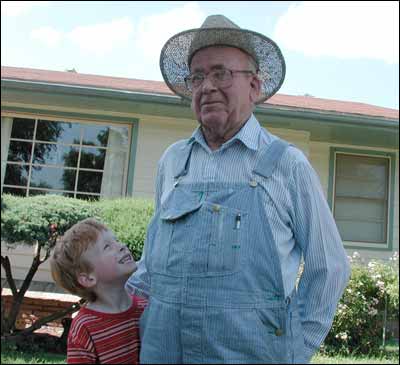
Elgie Unruh, with grandson Sam, in front of his former home in Pawnee Rock. [October 23] Most of you know Elgie Unruh -- 79-year resident of Pawnee Rock Township, carpenter, school bus driver, 4-H leader, Lions Club member, history collector, and rural letter carrier. I thought I knew all about him, too. But sometimes even a guy you know as "Dad" has a surprise in his past. Recently I received one of those surprises in a nice e-mail from Susan Beeler McKibben, who lives in Hutchinson. She said her family lived in a now-removed stucco house catty corner from where the Ritchies lived, at Bismark and Walnut. Here's what she wrote: "My father was Don Beeler and mother is Velma, sisters Sharon and Linda. "I lived in Pawnee Rock until 1964, I believe. I feel that I should remember you but I don't. However, I do remember your Dad. As you said, he drove the school bus I took out to my grandparents' farm. Many times in my life have I thought of your Dad. "I don't know if you remember but there was a big building on the main street about a 1/2 block up from the Hwy. They held auctions there in the evening. One night my sister and and I were playing out there and my little sister fell into a well. No one knew for sure how deep it was, but it was your father that went down into the well and brought my little sister out." This past weekend, I asked Dad about the rescue. He apologized and said he just couldn't remember, but he did like the Beeler family. And then a few days after Susan's e-mail arrived, I got a note from Barbara Schmidt, the daughter of Paul and Bernice Schmidt, who lived a half-mile west of the salt plant. Barbara lives in Washington. "I graduated from PRHS in 1969 and rode your dad's school bus for many years (my sweet Uncle Earl drove my bus before your dad took over the route). ... Your dad was just the kindest person, our security blanket on the way home every day (especially if the creek we crossed down near the Kasselman and Mull farms was overflowing, forcing the bus to creep slowly through the torrent of water). Elgie always had a soft smile for me when I climbed up into his bus, which I will always treasure." So, that's the word on Dad. He's fine these days, living in Great Bend and still driving his pickup every morning over to the Burger King, where Pawnee Rockers gather to shoot the breeze. Thank you, Susan and Barbara, for your kind stories. Also from Barbara Schmidt: Barbara had other memories of Pawnee Rock as well: "I was startled to find photos of my younger self on your website: "Spanish Club" and "Homecoming queen and court," both from 1969. As for Spanish Club, I was president (that's why they plunked me into the center of the photo) but don't remember accomplishing a single darn thing during my brief tenure in office (except saying "hola" and "adios" a lot). Mr. Rodriguez took the club to a Mexican restaurant in Great Bend one time -- eating tacos was an exotic adventure in my meek life then -- but that's all I remember the club ever did (Larry Smith was in the club, so you might ask him if we did anything else -- I bet not). I think the Spanish Club only lasted a year or two. "As for "Homecoming queen and court," if you would like to add names to the caption, I can give you all the names except for the two small children in the photo. The "court" girls are (left to right): Jolene Dirks, Edna Kasselman, Queen Cheryl Behrens, Barbara Schmidt, Barbie Manley and Karen Miller. I believe these were all the girls in our class at the time, so being named a "princess" wasn't exactly a mark of great accomplishment (although winning the "homecoming queen" title was). "And thanks especially for the photos and articles on the 1960s state basketball tournament. I rarely rode the school bus to out-of-town basketball or football games, but I think just about everyone in my class went to the last two games we played in that state tournament, including me. Those two games are still the most exciting basketball games I have ever witnessed (including the great games I saw while attending KU). Our Braves played magnificently because every player played with great heart those tournament nights (I had a big -- though silent -- crush on the entire team for at least a week or so afterward and am sure I was not the only PRHS girl with that reaction). I will never forget coming in 4th place in the finals but feeling like it was a huge, huge victory simply because our boys represented Pawnee Rock so well in the tournament. I also never cheered so hard in my life as during those last two games!" Chet Spreier and Brownie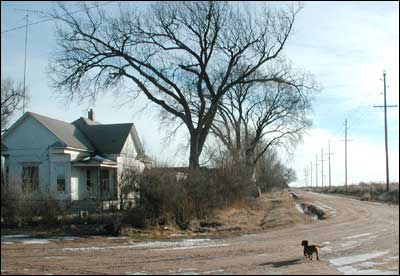
Chet and Doris Spreier lived on the county-line road at the south end of Centre Street. Their well-stocked garage was on the east side of their house. [October 22] Virgil Smith wrote Sunday to tell us a little more about Chet Spreier and Brownie, a beloved family friend. Here's his tale: Since your dad, Elgie, was a collector, probably you were familiar with former resident Chet Spreier and his penchant for collecting items from the past. Here is a little story that illustrates that. Brownie was a small, furry horse. He was about 18" high and had wheels -- just the right size for a small child to get on and propel around the room. He even had a handle with which to steer so that the rider didn't necessarily have to bump into the furniture. I think that he was given to my mother by a relative whose children had grown up. When Mother's grandchildren came over, they would ask for Brownie and he would get a workout. I'm not sure how old Brownie was, but in horse years, he had been around the block a few times. We hadn't seen Brownie for a while and really didn't think too much about it. Then, one day we went over to see Joan's uncle, Chet Spreier, and his wife, Doris, and, lo and behold, there was Brownie. We wondered how he had gotten so far astray. When Joan told my mother that she had seen Brownie at Chet's, my father was in deep trouble. It seems that he had decided that Brownie was too old and scruffy to be of service to the children anymore and had put him in with a load of trash that he was taking to the city dump. It was there that Chet had discovered and rescued him. We knew that he was in good hands and would survive to bring joy to more children. Chet was the world's greatest collector -- well, at least Pawnee Rock's greatest. When you went into their house, there would be collectibles on the tables, collectibles in the show-cases, collectibles on the stands and collectibles on the walls. Outside, the garage was not for the car, but for the collectibles. There were narrow paths to squeeze through and see them piled on each other and hanging from the walls and rafters. When there was an auction, Chet would be at the trailer looking at the boxes of "miscellaneous." When the auctioneer asked for an opening bid, Chet would bid $.25. Sometimes, the bid would stall there and Chet would get it. Other times, it might go a little higher, but I don't remember Chet getting too caught up in competitive bidding. He seemed to have a prospector's eye and mined a lot of treasure from the junk. I don't know if he ever sold anything. I think that he just liked looking at it. After he died, there was an auction in Larned to dispose of the accumulation of his lifetime passion and people came from far and wide to see and buy his treasures. Our other ecosystem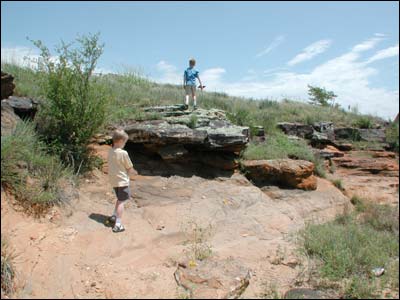
[October 21] One of the nice things about Pawnee Rock -- the Rock itself -- is that it is an ecosystem far different from the one the town sits in. The Rock, which is really the bleeding edge of the Smoky Hills, stands a few hundred yards north of the center of town and hundred or so feet higher. It's more arid than our elm-shaded burg. You'll find yuccas and dry-line Kansas plants on the Rock's slopes, and you won't find them growing naturally in town, which is essentially bottom land in the Arkansas valley. There among the touch-me-nots you might also find lizards. My fear as a kid was that rattlesnakes were lurking beneath the ledges of Dakota sandstone, waiting to strike an errant foot or an inquisitive hand. None of that stopped us kids from claiming the Rock as our second home, though. We scooted around and climbed over the cliffs and slick rock and sort of coasted down the sandy rock. 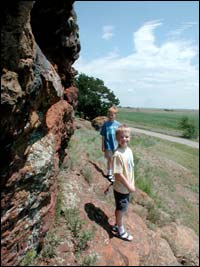 When we were young, the Rock was big and we couldn't get enough of it. For me, however, the Rock fell out of my life when I entered high school. But now, every time I'm in town, I want to spend a couple of hours on it, looking for names, feeling the texture, and trying not to get stuck by either a yucca blade or a rattler. You and I were like kids from the first days when Pawnee Rock was settled, like the kids on the wagon trains, like the Kiowa kids. As grownups, we tend to sedately walk over the grassy area and confine our thoughts to whether we can still see Seward from the top of the pavilion. At our ripe old age, we've started to believe all those childhood warnings about falling down and breaking our legs. (Who would drive the car home if we hurt ourselves?) You and I don't have to leave exploration to the whippersnappers, though. We can get as much as we want from the Rock -- the gritty, living Rock. All we have to do is think young. A photo I like: No. 57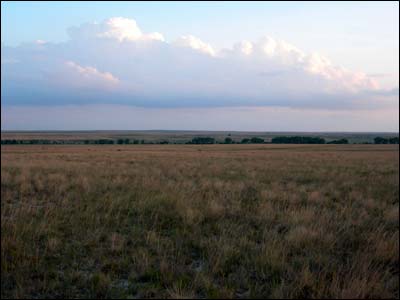
[October 20] Although I never met author Gretel Erhlich, I have considered her my friend since the day in 1985 when I read "The Solace of Open Spaces" while sitting in a laundromat on North Waco Street in Wichita. She wrote about Wyoming, but it was her appreciation of the big country that meant something to me. Over the following years, I swam in Hawaii's ocean, climbed hills in the Ozarks and mountains in Alaska, and stood on the edge of gaping canyons in Utah, and I felt as if the essence of open spaces was close enough to touch. I reached for it but never got it. And then late one August evening last year when I stood on the timeless grassland in Scott County, I understood. The air and earth took me in, and I knew a lifetime of peace in those few minutes. Kansas' day in the sunshine[October 19] This is somewhat off the topic of Pawnee Rock, but it was interesting that Kansas made the national news yesterday -- twice -- for something other than football, basketball, or murders by insane Kansans. Sen. Sam Brownback -- Despite being favored by 1 percent of the population, Kansas' senior senator is giving up his dream of generating name recognition and money in the presidential campaign. After he quits the race today in Topeka, he can lay the groundwork for acquiring the governor's office in three years. Who knows? Maybe that 1 percent of the population that would trust him with our country was all hardshell Kansas Republicans. It'll be interesting to see what kind of senator Brownback turns out to be when he's not measuring every action by how it would play in presidential politics.
Holcomb coal-burning power plant -- Kansans should be glad that the state's secretary of health and environment, Rod Bremby, denied a construction permit to Sunflower Electric Power Corp.'s proposed additional coal-burning power plant at Holcomb. (Utilities and in-the-know people like to call them "coal-fired" power plants, because it sounds so much hipper and cleaner. But anyone who grew up around coal-burning stoves might know better.) Here are four reasons why the decision is good:
Of course, the utilities will bring the legislators to heel and the plant might still get built -- unless the Kansans whose children would play in the mercury fallout raise cain. Reading for fun and survival[October 18] After four years of college and joining the working world, I suddenly I had more free time than I could imagine. So shortly after I moved to Austin, I began tearing through novels -- some trashy, some classic -- to find out what I had missed along the way. "The Grapes of Wrath," John Steinbeck's Great Depression story of a family of Okies who traded the Dust Bowl for inhospitable California, came into my hands. I was abundantly familiar with Oklahoma, having driven through it dozens of times, and I had a pretty good idea of what it was like to live in farm country. "Grapes" was a real underdogs' story, and I fell into it completely. This was during the time when the U.S. embassy workers were being held by the Iranian government, and it seemed as if war could come at any time. And with the steady arrival of displaced families from Rust Belt cities, it felt as if the recession was ready to become a depression. I figured I'd better be ready. I did situps on my little apartment's brown shag carpet, 200 a night after work. And to be able to feed myself if I were cast to the winds, I taught myself how to make biscuits the way Ma did in "The Grapes of Wrath." A little flour, some baking powder (or baking soda), shortening, and water -- and an oven or a covered pan over a bed of campfire coals. I understand that people have been making biscuits since flour was invented, and I concede that it would have been easier to look up the recipe in Betty Crocker's cookbook. But, I suspect, I wanted the real thing -- "Grapes of Wrath" biscuits -- because it would connect me to the harsh life my parents talked about surviving. I was prouder of that new skill than I should have been. But in those troubled times, it was proof that a kid out on his own could fend for himself. If he had to. Willie Wiredhand's book of life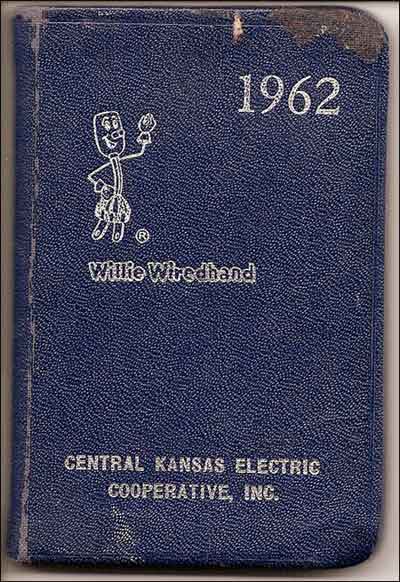
[October 17] You can have your Great Books of Western Civilization. The Bible, the collected works of Shakespeare, the Ilyad -- they all pale next to the pocket-size notebook handed out by the Central Kansas Electric Cooperative in 1962. This book, 2 3/4 inches by 4 1/4 inches, would fit neatly into the top pocket of a pair of overalls, right next to the pencil slot. And I imagine that's where a lot of them went in those days. In the late 1960s when I was about sixth-grade age, I found one of the books while I was browsing through boxes in the family attic on Otis and Lena Unruh's farm northwest of town; it probably belonged to my dad or one of his brothers. Wayne, the oldest sibling, worked at the Rural Electrification Administration plant in Great Bend for many years. Willie Wiredhand, the country cousin of Reddy Kilowatt and "the tireless hired hand who never goofs off," decorates the blue pebbled cover. But inside, the book is all business. It has the standard spaces for the owner's information (in case you forget your name, address, phone, and Social Security number), followed by pages of facts about REAs and then the statistics and details that make life worth celebrating: • A corn ear crusher will use 6 kilowatt hours per ton. • An ensilage cutter will use 7 KwH per ton. • An egg washer consumes 1 KwH for 2,000 eggs. (Of course, those were in 1962 KwHs; things are more efficient now.) • It is 715 miles from Atlanta to Chicago, 517 miles from Wichita to Denver, and (for those who had to escape) 1,928 miles from Wichita to Seattle. • A bushel of corn meal weighs 48 pounds. Alfalfa comes in at 60 pounds a bushel, as do soybeans and wheat. If you're toting Bermuda grass seed, plan on 35 pounds. • There's a guide to first aid: fractures, poisons, cuts and scrapes, and unconsciousness, no doubt an interesting section for a reading audience at risk of heatstroke and heart attacks. • There is a conversion table for fractions to decimals, and a table showing "Amount of One Dollar at Compound Interest" for up to 100 years at rates from 3 percent to 6 percent. Anything higher back then was highway usury. • Double riveting is from 16 to 20 percent stronger than single. • To find the pressure in pounds per square inch of column of water, multiply the height of the column in feet by .434. • One cubic foot of anthracite coal weights about 53 pounds. Behind all that was an address book, a few pages to keep track of Social Security payments, a section dedicated to "memoranda," and a small ledger for cash accounts. I can't tell you how many hours I spent sprawled across a bed reading the information and admiring the sureness of the numbers. It occurred to me as I write this that Willie Wiredhand's little book must have been a great companion as well for a farmhand eating lunch in the field or for a husband waiting in the grocery store parking lot. Or even for the gentleman with time on his hands in the little house out back. "Last Dance at the Frosty Queen": Cheryl Unruh's column in the Emporia Gazette this week is about Richard Uhlig, who grew up in Herington and wrote a novel about a young man desperate to get out of town. There's more about him on Cheryls site, Flyoverpeople.net. The Ghost of Halloween Past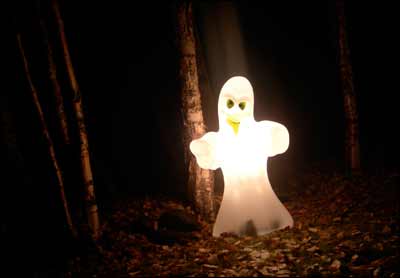
[October 16] Our families sent their emissaries -- ghosts, hoboes, little plumbers, and dainty princesses -- out at dusk. Up and down the street we'd go, knocking on the doors of houses we knew held friendly families. Our pillowcases and paper grocery sacks -- this was before plastic was an option -- would collect the night's bounty, and we'd come home and eat ourselves sick. Our moms made the costumes for the smaller set, and the larger ones helped themselves to the clothes hanging in the deepest recesses of their parents' closets. Kids who thought ahead went to Duckwall's in Larned and bought a pungent mask with an elastic string that held it on. For one night, we were the royalty of the horror-fashion world. By now, you're probably wondering why there's a discussion of Halloween a full 14 shopping days before the Big Night. On the other hand, you may be tired of Halloween already. Wal-Mart started putting out its Halloween goods after Labor Day, ungraciously short-changing the shelves of their Christmas bounty. Orange bags of candy and fright masks have long been for sale, along with this year's atrocity -- a talking torso whose arms lift the head off the bloody neck. With the sole exception of candy corn, there's nothing good that comes the early sales of Halloween goods. All Hallows Eve seems to have been turned into the appetizer for the Christmas shopping season. It has even taken on Yule trappings. In our neighborhood, far from Pawnee Rock, there are houses with orange and purple lights -- strung up like Christmas lights -- and illuminated plastic ghosts that glow in the fog under leafless trees. Some houses, and this isn't limited to our neighborhood, install inflatable ghosts in the front yard yard until it's time to drag the inflatable Frosty and Grinch out of the garage. (A confession: The plastic ghost is ours and I like it. Its name is Spooky. Another confession: I've already chosen my Halloween costume -- I'm going as Santa Claus.) Sadly, however, while chocolate fun remains part of Halloween, it's no longer a night dedicated to youthful ingenuity and mothers' handiwork at the sewing machine. The Halloween-industrial complex demands our complicity, and it's a lonely kid whose costume doesn't come from a store with a pre-established commercial tie-in. When you and I dressed up way back then, we could imagine ourselves to be anything we wanted, and if we believed it other kids would play along. There weren't any expectations other than that we'd have fun. Now, for any number of reasons -- two wars, a gamey economy, incessant advertising, terrorists behind every shipping container, kidnappers behind every school, and security cameras everywhere -- we're pretty uptight. I think we acknowledge that nothing's as much fun anymore, not the way it used to be. But we don't have to tell the kids that, do we? You and I, we can still laugh in the face of the boogeyman and not have to explain ourselves. So in two weeks give the Wonder Women and Transformers at your door a little extra candy. Let's celebrate the reason for the season. The bad air at Plating, Inc.[October 15] Virgil Smith wrote from Arizona: "Your article about the pollution done by Plating, Inc. brought back memories for me. In the early 1980's I transferred from the Pawnee Rock post office to Great Bend and began delivering mail on their Rural Route #1, which I did until my retirement in 1989. It was mostly west of Great Bend and included several industries and businesses at the industrial park at the airport. Plating, Inc. was one of them. "There were times when I had mail for them that required a signature for delivery. I would go into the building and be amazed at the operation. There were large vats of acid where they were electro-plating steel parts with chrome. I think that their main business was with Great Bend Industries, whose factory was just east of them. GBI made hydraulic cylinders and pumps and related items. "When I went into Plating's building, the odor was strong and seemed to bother my eyes and nose. I wondered how the workers could tolerate it all day, day after day. "I don't know how much they were aware of the problems that they were causing to the environment, but you would think that, when handling such hazardous materials, they would find out and take steps to protect the environment and the health of their workers." Something in the water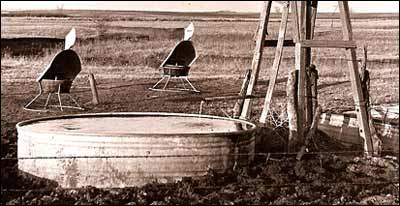
[October 14] Back in the 1960s, Pawnee Rock students were treated to lyceum programs -- lectures and demonstrations by experts and explorers who went on a school-to-school circuit. One show I remember in particular was given by a couple who bicycled across Australia. The woman told about how much of the continent is a desert beset by kangaroos and rabbits. The cyclists rode day after day without passing rivers or ponds, but one day they came across a tank of water. They washed themselves under the spigot and drank deeply. And then, to get a view of the countryside, one of them climbed to the top of the tank. It was open. There in the water was the carcass of a rabbit. That little bit of pleasure came to mind yesterday when I got a note from Leon Miller, following up on my photo of the wooden windmill southwest of Pawnee Rock (now in the photo gallery). Leon wrote: "The windmill in your photo today could have been one of many built & installed by my grandfather, Arthur Miller, or uncles, Elmer & Vic Miller. "Arthur was a plumber and since indoor plumbing was a rarity until the 1920s, his main trade was building windmills. Upon his death in 1928, his two sons, Elmer and Vic, took over the business, which remained active until Vic's death in 1967. "I remember going out to a farm with my Uncle Vic and servicing windmills that would be clogged with frogs or toads that stopped the mill from pumping water. It was a pretty gruesome sight to see the remains stuck to the wellhead and knowing this family had been drinking the water that came from it. "The funny part was when we mentioned this to the man & wife they just shrugged their shoulders like it happened all the time. It didn't bother them." Sporting news: Saturday was a shining day in Kansas sports. In college football, Kansas beat Baylor K-State beat Colorado. In stock-car racing, Emporian Clint Bowyer came in second. And in our favorite sport, basketball, practice has begun. It won't be long now until we have a good reason to watch TV. Here are the schedules for Barton County Community College, Wichita State, Kansas State, Fort Hays State, and Kansas:
A photo I like: No. 56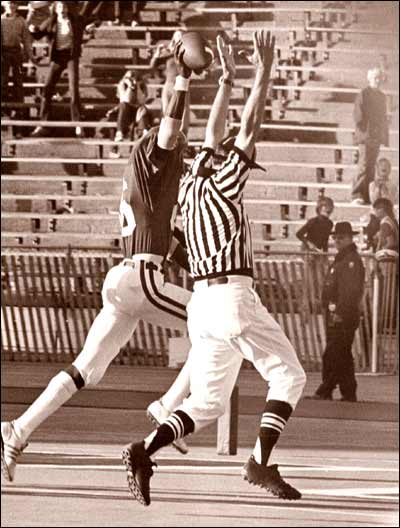
Waddell Smith scores a touchdown for the Kansas Jayhawks against the Colorado Buffaloes, 1975. [October 13] Because I had spent the summer working for the Larned Tiller and Toiler, I was able to talk editor Jack Zygmond into sponsoring me for a sideline photographer's pass at the University of Kansas football stadium. That was pretty cool for a freshman. I set up a darkroom in a closet in Stephenson Hall, where I lived, and developed the film and printed a few pictures for delivery back to Larned. I was fortunate that the Lewises, parents of one of my friends from Larned, came to every home game and were willing to carry the packet of shots to the Tiller office. I got $4 for every photo Jack used, which usually was two or three a week. I didn't have a motor drive or even auto exposure, like the photographers from the big newspapers did. All I had to my advantage was a sense of how the play was going to develop -- and I credit that to my one and a half seasons of junior high football and to four years of filming and photographing high school games in Pawnee Rock and Macksville. And that's how I happened to be the only photogapher who got this photo of Kansas wide receiver Waddell Smith scoring a touchdown on a pass from Nolan Cromwell late in the Colorado game in 1975. I like the airborne symmetry of the joyful Waddell and the referee, and there's that happy kid in the end zone bleachers. Waddell, who went on to play in the Canadian Football League with the Edmonton Eskimos and then in the NFL with the Indianapolis Colts (1986), told me the shot was one of his favorites, which pleased me because he was one of my favorites. Barton County Superfund cleanup proposed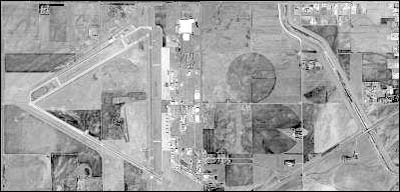 The Great Bend airport, the industrial park, and Great Bend housing to the east. [October 12] It is good but not especially reassuring to read the Superfund report for the Plating Inc. plant at the industrial park at the Great Bend airport. I like the fact that the state and now the federal government are trying to clean up the site, but I'm hacked that the company did that to our county in the first place and that the ground is likely going to stay polluted. Pawnee Rock, which until recently had many families on their own wells, is fortunate to be uphill and up-aquifer from this plant, which has an underground plume of chromium extending northeast from it. When I saw John Green's story about the plant in the Hutch News, I went to the Superfund section of the EPA site and found a history of what has been done to try to clean up the damage. It made me think of pollution I saw back in the mid-1970s -- a pipe pouring green gunk into the Arkansas River southeast of the airport industrial park. I wonder whether they're related, or was there more than one company polluting our water? Chromium is one of those metals that your body uses well in minute doses. Large doses are toxic. Behind the house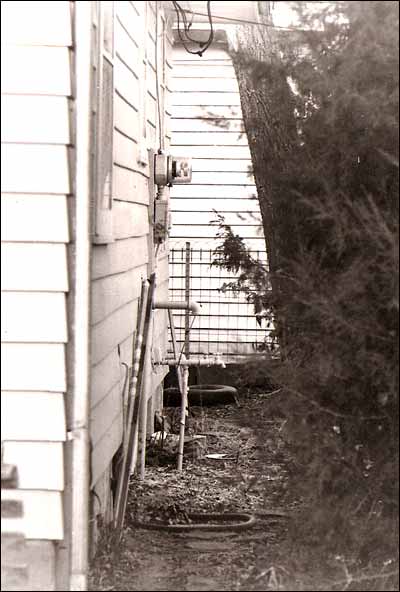
October 11 I was sorting through some 1970s photos of Pawnee Rock and came across this shot of the back of the house where I grew up. The window near the corner was to my sister's bedroom, until she moved to a different room and that became my darkroom (I covered the window). Sometimes songbirds landed in the cedar outside the window. A walkway of four or five feet extended between the house and the trees and a sweet honeysuckle vine on a lattice you can't see here. Leaning against the house is a long pole with white bands. That was a 2 x 2-inch by 8-foot board that Dad planed the corners off of to make an eight-sided pole so I could amuse myself pole vaulting over bamboo crossbars. The white bands are strips of athletic tape I added to provide a grip. I think I cleared the crossbar set at 4 feet a few times, and I can still hear the pole hit the ground. Years earlier, along the painted concrete wall on this former basement house, I played with doodlebugs in the soft dirt. Sometimes I farmed wheat there, just like Grandpa, with my green toy tractor and plow and drill. The next window was the bathroom window. I was pretty old -- maybe 12 -- before I could look comfortably through it (from the inside). The electric meter was a fascinating machine to watch when the refrigerator, furnace, cooler, or washer turned on and off. Under the meter is a pipe to vent gas from the plumbing system. I never got too close to that ominous pipe, but nearly under it was the faucet, which provided the water for backyard fishtanks (refrigerator drawers) and whirling sprinklers to run through in August. Past the meter is the kitchen window, which looked out on the birdbath, the swingset, and the cedar-protected junky shed and lumber pile tucked into the northwest corner of the yard. Beyond the elm tree was the Tutaks' house. Now, I know this photo means more to me than it does to you, but that's not my point. I think each of us has a part of our old home that we would enjoy visiting again, a certain place where we might like to play in the dirt -- just one more time -- if we knew nobody would see us. With a little luck and the right photo, we might remember the happy days when our world was new and everything was possible. The Gospel singer[October 10] Bonnie Laughlin Deuschle is in the news this week because she and her husband and kids, who live in Africa, are coming to Great Bend for a Gospel music concert Saturday evening at Barton County Community College. You may have read about it yesterday in the Tribune. I didn't have a big sister, but if I had it would have been Bonnie Laughlin.
Bonnie let me talk her into playing tennis one morning on a court by the armory -- and it was evident that I wasn't anywhere near her league. She laughed, but she was kind. She was a steadying influence as I finally worked my way into the Rebels' horn line in my third year with the corps. I needed a confidant, and she, another bugler, was ready to listen. One time I brought her a romantic problem, and although I don't remember her answer exactly, I do recall that she quoted her mother, Jeanine. "My mother is so wise," she said -- and that was Bonnie as well. My favorite Bonnie story is about how she made her own luck. When Fred Waring and his Pennsylvanians came to Great Bend for a community concert, Bonnie took her soprano voice backstage and met him. I don't know whether he offered her a spot in the chorus that night, but he loved her voice. She went to Barton Juco and then to Oral Roberts University, where she became Miss Tulsa; going to a religious school and being the best and the brightest suited her personality. And so it was no surprise that she ended up singing for Jesus and going off with her new husband to Zimbabwe, which 26 years ago was the bright beacon of postcolonial Africa.  The concert publicity information says she has written more than a hundred songs and recorded several solo albums, and she's a pastor. She always did have something to say, and she has a voice that years ago I found the name for: amadeus -- beloved of God. I haven't seen Bonnie since the early 1970s, yet if she walked in the door tomorrow I would know her by her aura. Thirty years ago, it was clear that Bonnie Laughlin was meant for a big life. Speaking of music: The third annual Fall Gospel Sing Concert will be 1 to 9 p.m. on October 27 in the Fine Arts Auditorium at Barton County Community College. Don Paden, who you may know from Pawnee Rock's Christian Church, is one of the singers (with Johnnie). Others on the playbill are Larry DeLawder of Branson, Missouri; Praise to Him, from Paris, Missouri; Three in Harmony, of Haysville; Ed Huffman of Maize; The Toneys of Gallatin, Missouri; Melanie Ryan of Great Bend, Sound Advice Quartet of Topeka, and Ambassadors of Grace from Centralia, Missouri. For more information, call 620-792-7664. Admission is free; a freewill offering will be accepted. Roy Dirks: Roy Dirks, who was born in 1916 in Pawnee Rock to Jacob and Carrie Dirks, died Tuesday in Great Bend. He was a farmer, World War II veteran, and barbershop quartet singer. He is survived by his wife, Mary. He was a member of the Bergthal Mennonite Church of Pawnee Rock. (Full obituary on October 10) Make a Pawnee Rock video[October 9] Our friend Peg Britton in Ellsworth passed along some links to homemade YouTube videos about Ellsworth -- the town and the Top 40 song by Rascal Flatts. People like to sing the song about Grandma's life, and a few people have put photos of Ellsworth to the music. Sometimes having cattle drives and a state prison and lots of history in a scenic setting just aren't enough to get your town's name mentioned every day across the nation. Appearing in a famous song is one way to do it, but once in a while you've got to help it happen by making a video and putting it on the Internet. The videos don't have to be of professional quality. The important thing is that they're out there to be watched. • "Ellsworth" with Ellsworth scenes Now, I know there aren't any Top 40 songs about Pawnee Rock, but you're working on one, aren't you? Until we hear that song, how about this: Anybody with a digital camera can make a 1-, 2- or 3-minute video about Pawnee Rock (or set in Pawnee Rock) and put some music or narration to it. It doesn't have to be funny, but it wouldn't hurt. It doesn't have to be a music video, although people like those. It could be a quick tour of downtown. Think of it as a sales brochure or a biography. Signing up with YouTube takes a couple of minutes, and it's really easy to load a video. When you send it to YouTube, let me know and I'll brag about it here. Do it for our town and for yourself. Make some fun. Norman Converse, mentor[October 8] I got an interesting e-mail late last week from Virgil Smith, Pawnee Rock's longtime rural mail carrier. He had some anecdotes and history that needed to be passed along. Here's what Virgil wrote: "You earlier posted pictures of Norman and Margaret Converse. Since they were prominent in the history of Pawnee Rock, I'd like to tell you some more about them and some related memories. "In early 1954, Joan, my two older sons, and I were living in a house south of the highway owned by Bill and Flo Barnes. Flo was formerly the wife of Fred 'Slim' Kennison, who had died. Slim was the janitor of the Pawnee Rock schools for many years (during my student era). Slim tried to be gruff with some of the ornery students, but was really a 'Paper Tiger.' It was apparent that he loved being around the kids. He had lost part of his thumb by some kind of accident and would grab a kid and pinch their arm or finger with his stump. He was kind of like a Disney pirate that frightened you, but you loved it.
"He introduced me to his clients and showed me his method filing the returns. He kind of adopted me. Probably more than I wanted to be, but I knew that he had my interest at heart, as well as the interest of his clients. Since his eyes were bad, I often shaved him in the office and drove him on errands in his Studebaker. It was the one with pointed nose that looked like an airplane and was fun to drive.
"There is more that I could relate, but I'm afraid this would get too long." Virgil's modest concern about story length notwithstanding -- there's always room for good stories -- I asked him where he had been working before he hooked up with Norm. Here's his reply: "I had worked as bookkeeper for Mullin Furniture in Great Bend, but the summer prior to this time, my father had talked me into going into farming with him, so I farmed in the summertime and Mullins let me work in their delivery department when I wasn't farming. I guess that I was like many young people who want to get ahead and live the good life, I was willing to do some moonlighting to accomplish it. "I want to add to my information about the Converses that I thought that both were very good business managers with precise and neat record-keeping and a dedication to giving their customers good service." Now, it should be noted that Virgil not only succeeded Norm, but he also succeeded Margaret Converse. Virgil became the postmaster in 1957, then passed it along to Roger Unruh less than a year later. When Roger left the position, the job went to Joan Smith. (List of postmasters) (Thanks to Don Ross for supplying the photos of the Converses, which were taken by his uncle Dean Ross, also a former postmaster and longtime rural carrier.) A father is vindicated[October 7] We might look back on our town's old days and remember or imagine only rosy times, but surely that is turning a blind eye to reality. How many things happened that our parents never told us about because they brought up bad memories or humiliation? What crimes were never spoken of? Leon Miller of Dallas, the son of Cobb Miller, the Mobil Oil jobber in Pawnee Rock, writes that his dad was cheated during the construction of the Pawnee Rock school fifty years ago. Leon tells us how the unethical practices of a construction superintendent caught up with him. Leon used the contractor's name, but I disguised it because mentioning it here would put this file on the first page of a Google search for the company's name and I don't want to disparage the present company for the deeds of a superintendent decades ago. Here's Leon's story: Contractor digs his own holeWhen the "new" school was built in 1956 my dad, Cobb Miller, supplied gasoline and motor oil to B------ and R--- Contractors, the contractor building the school. He even provided the contractor a tank to store the fuel. But when the job was over, the contractor took the tank with him despite a vehement protest from my dad to pay him for it. Alas, the job superintendent more or less said, just try to get it from me, and left Pawnee Rock, never to come back. But ironies of irony, years later B------ and R--- came to Dallas to cash in on the work going on here in the 1960s. They bid on a small project for the City of Dallas Parks & Recreation Department that was built out in West Dallas, and was designed by my employer at the time, Harwood K. Smith & Partners Architects. They got the job and started construction. It so happened this same superintendent that had built the Pawnee Rock school was the superintendent on the City of Dallas project. And it also happened that I was in charge of all field operations for the Smith firm at the time (1963). I remembered the remarks my dad had told me about B------ and R--- and how they had cheated him out of the cost of the fuel tank (maybe several hundred dollars' worth). So I kept a very close eye on how they were building this project. They started building the walls of the building and were up about 3' high when I noticed they were not putting wire reinforcing in the walls as called for in the plans and specifications. But the superintendent chose to ignore my directions and continued working. Several days went by and when I came to the project the wall was about 8' high. Again, the superintendent argued that reinforcing was not needed and refused to put it in. Finally, the wall was up to its full height (maybe 15' - 16') and the superintendent submitted his draw for the month, which included the completed wall. I simply asked him, "Does it have the wire reinforcing in it?" He replied, "No!" So I said, "Tear it down and build it right!" He was furious and tried to get me fired and get the Smith firm fired. But everyone backed me for doing my job. The wall came down and was built correctly. My dad was vindicated as reconstructing that wall cost a lot more that a gasoline tank.
Brock Unruh came (back) to Kansas from Corpus Christi, Texas. He was born in McPherson in 1986, and his dad, David, long ago played football for the lamented Wichita State program. Here is Brock's page in the K-State roster. That said, we can move on to chanting "Rock Chalk." Watching the Jayhawks go into the K-State stadium and bell the cat makes for a heartwarming day. Thank you, K-State, for beating Texas a week ago so you could force the Kansas game onto national cable television and let Kansans around the country watch KU win 30-24. A photo I like: No. 55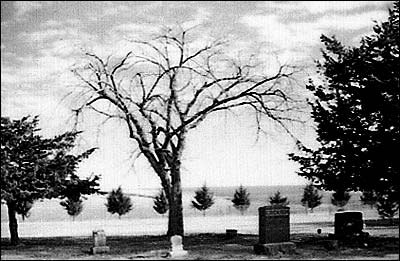
[October 6] This peaceful scene from the mid-1970s at the Pawnee Rock Cemetery has several elements I like. The bare-limbed tree bespeaks death, but it's surrounded by evergreens. The heart-shaped stone in the foreground bears one name, the very emblem of heartbreak. The Erickson stone -- sturdy and tall -- dates to Anna's death in 1924 and is somber and stolid, but Erick's and Anna's "Father" and "Mother" are etched in cursive. Shadows fall across the near ground, but in the new part of the cemetery, the sun shines and cedars only a half-decade old grow with a long future ahead of them. The deciduous tree and the little cedar little tree at the left are gone now; the cedar's stump remains. The wide-open eastern side of the cemetery is filling in from the west. Hello, Leonard Unruh: Leonard Unruh, a son of Elmer and Lorene Unruh, who lived north of town, has joined the Friends of Pawnee Rock. Leonard lives in Arkansas now. The riverbed at hand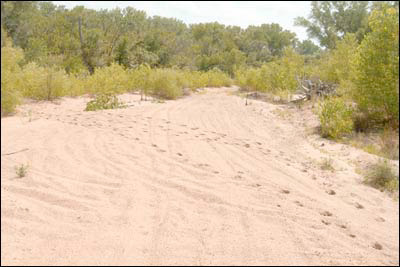
The Arkansas River's sandy bed upriver from the Pawnee Rock Bridge. [October 5] Anytime I go back to the Arkansas River, I like to walk to a quiet place and sit in the sand. I usually find myself there in the summer, when the sand is hot. Of course, it's all different from when I was young, because in most summers there's no running water in which to give my feet relief, no muddy aroma, no sense of "oasis." But there can be surprises. A year ago August, not far up from the Pawnee Rock Bridge, I found the trail left by a beaver dragging its flat tail into a stand of willows. I have a winter hat made of a beaver pelt -- it's so warm I can't wear it unless the temperature falls below zero -- so I know I wouldn't want to wear a beaver coat on the dry summertime Arkansas River bed. But there they are -- beaver tracks. The sand that used to hold little dried-out snail shells and waterbird tracks holds a different kind of biological memory now, the kind that comes with stagnant water and willows. Trees have taken over the riverbed, and once anchored they are loathe to give up their hold to any short-term high water (flow at O'Rourke Bridge). They attract dry-land insects and songbirds, and their exoskeletons and feathers are what appears now in the sand.  The gravels and sands once were polished and streamlined by running water as they were rolled unceasingly toward Oklahoma. Now the sand is beset by unnatural forces -- four-wheelers beating nature's fleeting sculptures into a flat, homogenized human form. For the childhood river we rode inner tubes on is now a long sandbox with sullen mudholes, its sustenance sucked out from under it by cities with green lawns and by the machinery of agribusiness. I kneel in the Arkansas' sand and pick up a handful of feldspar and quartz and other gifts from the Rockies. I pour most of it to the side and gaze into the rest, a thousand worlds in my palm. Up and down the riverbed, bank to bank and under it, lie uncountable billions of worlds. So here I am next to a willow, shaking sand out of my shoes while swatting flies and trying to open my mind to the wonders of the riverbed; I never quite comprehend that I have to quit trying if I am to succeed. Once in a while, however, I catch a glimmer as time slides around me, and I see that I am just another mammal pausing where a geological blink ago there were bison. We've all spent time at the river; it is one of the perks of living in Pawnee Rock. We get as involved with the river as we want to, from picnicking under the cottonwoods to shooting beer cans to romancing and skinny dipping and fishing and camping. I did all those things, and I'm glad, but I wish I had spent more time documenting and protecting the river. Because, for all the minuscule worlds at my feet, this one is my world. First acts on stage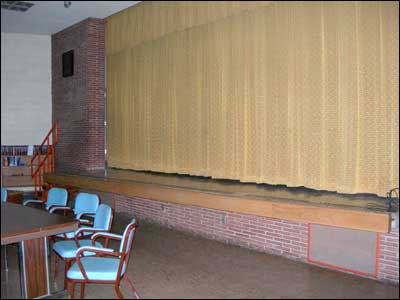
The auditorium stage in the Pawnee Rock school lunchroom. [October 4] My call to the stage began in grade school when our class performed a song for other classes seated in the lunchroom. We trooped up the short flight of wooden stairs, maybe holding on to the orange-painted square rail. We stood well back from the edge, because for a little kid a two-foot fall -- or jump -- is a long way. The boys had their hands at their sides, and the girls clasped theirs in front. Maybe our parents also came to see the show, and maybe the stage lights were turned on. Maybe most of us remembered the words, rhythm, and melody that Mrs. Schmidt had been drilling into our little heads, but probably not. We sang along with Mrs. Schmidt. And then to outrageous applause we walked down, in relief and in single file, and the next class assumed the position. 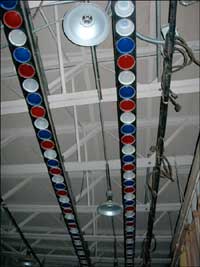 There were also the 4-H meetings, each of them with a skit played out on stage. I'm sure the grand purpose was to encourage our public-speaking skills, and it might have worked. All I know about public speaking, I learned on that stage. I prayed that my pants were zipped and that I wouldn't fall down. Forgetting the words wasn't a big crime because we all did it no matter how much we practiced in front of our moms. And our moms still loved us, but we performers were at that age when we would rather have crawled under the table than let Mom hug us in public. Some kids took to the spotlight. In my class, Ida Deckert and Jim Ellis had voices and weren't afraid to use them. The Stimatze kids, spanning four or five years, performed well as a group. The Lions Club at least once had a talent show on the lunchroom stage. Although it was played mostly for laughs, a few dads put their hearts into it. Some guys sang, for example; one fellow thumped a gut bucket like a bass fiddle, another blew across jugs, and my dad played the saw, hammering it lightly as he bent it to change the tone. That's stuff you don't see on TV. And we saw it all on our little stage in the Pawnee Rock school lunchroom. We suffered together and we bathed in applause together, and it bonded us into a community. Fire in the fields: After reading Virgil Smith's tale yesterday of the hard life of a plow, Leon Miller remembered an exciting part of farming: "I recall many instances whereby farmers would burn the stubble rather than leaving it stand. They would plow a fire break about 10' to 15' wide around their field to prevent the fire from jumping over to their neighbor's field, then light the match and 'watch it burn.' "Like so many other lessons, it took some hard experiences of dust storms before they were taught the values of preventing soil erosion and saving their land." Kansas Memory: The KansasMemory.org website heard my wail of complaint about the dates attached to the Pawnee Rock photos. (Thank you to whomever passed it along to the site's organizers, and thanks to KansasMemory.org's staff for moving so quickly.) The dates have been updated. While you're on the Pawnee Rock page, take a while to read Harriet Bidwell Shaw's account of crossing the plains in 1851. Her account reaches "a large rock called Pawnee rock" on October 9 (page 13). I recommend the site; it's one I wish I had created. Pawnee Rock's last blacksmith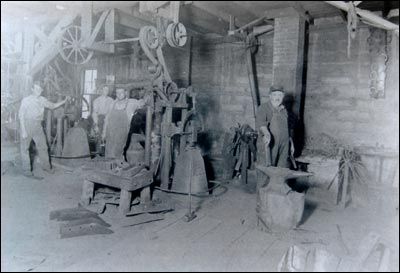
Dutch Smith and employees in his blacksmith shop in Pawnee Rock. Plowshares are on the floor, and horseshoes are on the wall. [October 3] We Pawnee Rockers born after World War II all knew in the back of our heads that Pawnee Rock had had a blacksmith in the early decades of the 20th century; every town had to have one. But few of us know anything about the town's last smithy -- Dutch Smith. Virgil Smith, who grew up with his brothers on Elrick Smith's farm northwest of town, remembers Dutch. He sent along a few paragraphs that say a lot: Dutch, the blacksmithIn the 1930s, it was a common practice for the farmers to get into the fields as soon as possible after the wheat was cut, to plow the stubble under. They believed that the more they could plow under, the more nutrients would be added to the soil. Probably they were right, but it made the soil vulnerable to water and wind erosion. After a hard rain, there would be gullies on the hillsides from the erosion that had to be plowed shut before the fields could be planted. This was before most of the fields had been terraced. Later, other methods of tillage were used to conserve the soil by leaving more straw on the surface. Many farmers put lights on their tractors and, if they had the manpower, would plow during the night. Most tractors did not come with factory-installed lighting that early. Before hard-surfacing came into practice, the plowshares would get dull and have to be sharpened. We would remove from the plow and take them to "Dutch," the blacksmith in Pawnee Rock. I think that his last name was Smith, but I"m not sure. Most farmers just knew him as "Dutch." Dutch was a large man -- maybe not so tall, but his upper arms were the size of most men's thighs. His muscles were not made by pumping iron in some gym, but by plying his trade as a blacksmith. In the summer heat he would take off his shirt and work in his undershirt. Men and boys wore undershirts in those days until a movie came out in which Clark Gable, or some other heart-throb, took off his shirt and revealed a bare chest. After that, the virile young men and boys knew that, if they wanted to attract the young ladies and girls, they had to ditch the undershirts. Dutch's shop was north of the building that Willard Wilson later used as a welding shop and was torn down long ago. In the corner there was a forge with a blower on it. I think that it was hand-cranked and blew the draft under the center of the coals and they would glow white-hot. Dutch would put the shares in the coals until they were turned red by the heat. Then he would take them out with large tongs and lay them on an enormous anvil and taper the edges by pounding them with a large hammer. When he was satisfied with the results, he would dip them in a vat of water and let them cool. After they were cooled he would smooth and sharpen them on a large emery wheel and put them in a pile with the customer's name written on the top one with chalk. It seemed that Dutch could build or repair almost anything that the farmers needed. 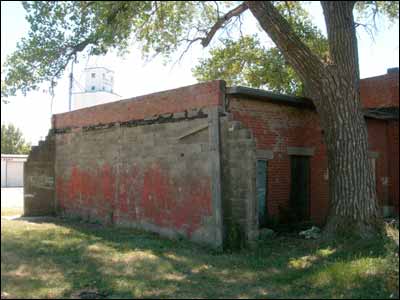
Dutch Smith's blacksmith shop stood to the left, or north, of the building Willard Wilson later used for his welding shop. In the next lot north, between this shop and the site of the Christian Church, a livery stable once stood. The light in the sky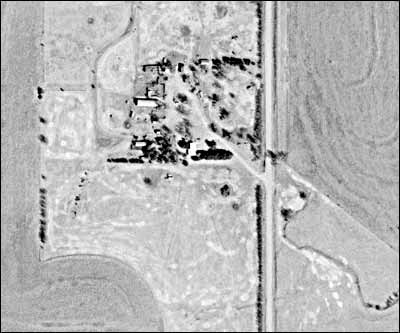
Durward Smith's farm, west of the gravel road, as seen from orbit. [October 2] Thursday is the 50th anniversary of the launch of Sputnik, the Russian satellite. Some of you grandparents probably saw it slip across the sky and may have -- some of you did, in fact, according to newspapers -- felt as if the commies were about to take over the world. Fortunately, the immediate fear dissipated when the United States joined the space race. By the time I was old enough to know what a satellite was, we had some of our own and men in space too. (Thanks, by the way, for deciding that we young'uns needed to study more science.) I saw my first satellite in the mid-1960s. My dad and I had driven out to Grandma's place northwest of town, and on the way back we stopped the pickup to talk to Durward Smith along his osage orange shelterbelt. It was one of those summer evenings after harvest when our part of Kansas was at rest. The air was light, and the sky was clear. While Dad and Durward talked, I remember, I kicked around in the road sand until I heard Durward mention something about a just-launched satellite. The best time to see it had been printed in the newspaper. We turned our eyes to the deepening blue and waited. And there it was -- a dot of light, illuminated by the setting sun as it sped northward over our heads. No contrail, no sound, just a pinpoint. These days, a flock of satellites hangs in place over the earth or makes mindless orbits. We hardly think anymore of the miracle of those little moons. We use them for global positioning, for TV and phone calls, for checking out our house from the sky. What was once a scientific marvel is now our birthright. But once in a while, we'll look up at the stars and see a dot of light moving faster than our imagination. And maybe you will, as I will, think of the first time we saw a satellite -- the never-blinking light of the future. See the space station: Larry Mix was reading the site well before dawn this morning in Stafford County and sent this message: Your story today about "Light in the Sky" made me wonder if you can see the International Space Station from Eagle River, Alaska. Well, from this page you can look up when you can see it. On the left side of the page is a link to the state and nearest city you live in and then the times it can be seen. Or from this page go to "real time data -- sighting opportunities" then on to your state. Here's the page for Great Bend. Other neat sites from this page will give you tracking of the ISS and other neat stuff. Enjoy!! New Kansas history site[October 1] Our friend Larry Mix of the Santa Fe Trail Research Site forwarded a press release announcing the impending launch of the KansasMemory.org history website. I checked it out and found a lot to like: photos, printed and transcribed records, and easy navigation.
To be fair, the KansasMemory.org site isn't officially launched yet and there may have been pressure to make it public despite not having all the details just right. And it looks as if things are still being sorted out at the headquarters in Topeka. I first tried the site at midafternoon Sunday, and a bit of information said the details had been verified. When I visited again six hours later, the verification vouchers had been removed. I'm sure that as time passes, KansasMemory.org will get feedback (once it adds a "contact us" link) and update the site. Heaven knows, PawneeRock.org faces the same problems in the search for facts and perspective. Anyway, here's the press release: LARGEST ONLINE COLLECTION OF IMAGES AND DOCUMENTS FROM KANSAS HISTORY TO BE LAUNCHED OCTOBER 16 Former Kansas Governor John Carlin to be on hand at launch event TOPEKA, KS -- The Kansas Historical Society announced that former Kansas Governor John Carlin, who served as Archivist of the United States from 1995 to 2005, will return to Topeka for the launch of Kansas Memory on October 16. Kansas Memory is the Historical Society's newest online offering, featuring the largest collection of photographs and manuscripts from Kansas history on the Internet, and can be accessed at kansasmemory.org. Carlin and other state dignitaries will be on hand at the Historical Society, 6425 SW 6th Avenue, for a launch event at 10 a.m. on Tuesday, October 16. The launch coincides with American Archives Month. Kansas Memory offers unprecedented online access to Kansas history and includes thousands of items from the Kansas Historical Society's collections of photographs, letters, diaries, and other historic items. Users can browse, search, or share images, and will eventually be able to purchase high-resolution versions online. The "My Memory" section allows users to customize a personal space, save searches, and create scrapbooks of items. Although it would be impossible to add every single item in the Kansas Historical Society's collection to Kansas Memory, the Historical Society will actively continue to add images as part of its goal to make Kansas history more accessible to everyone. Visitors to the site can listen to dramatic readings in the Kansas Memory podcasts and subscribe to web feeds for the latest content. Teachers will find the multifaceted browse feature especially helpful as it includes topics that help meet Kansas and U.S. history standards. Kansas Memory was developed in part with funding from the Information Network of Kansas. During the month of October, Kansas Press Association member newspapers will have access to a special collection of photos from Kansas Memory for use in their publications. This partnership between the Association and the Kansas Historical Society celebrates National Newspaper Week, October 7-13. For more information on Kansas Memory, visit kansasmemory.org or call Pat Michaelis, Kansas Historical Society State Archives & Library Director at 785-272-8681, ext. 270. NASCAR pulls a fast one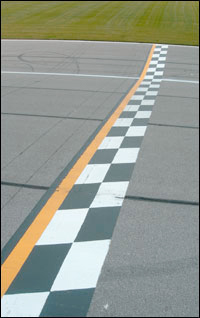
We watched Sunday's televised NASCAR race at the Kansas Speedway in Kansas City. It was fun to share with the rest of the country a bit of prairie weather -- the wind, the fast-moving thunderstorm, and the day's rapid descent into darkness. Of course, it wasn't a perfect day. Three hours of rain delays and a handful of accidents pushed the end of the race past sunset on the unlighted track. Finally, the race was cut short during a yellow flag because of debris on the track and the victory was given to Greg Biffle, who didn't cross the finish line first. A lot of drivers thought Kansas' own Clint Bowyer really won the race, going by the rules, but NASCAR officials apparently weren't going to give it a second thought -- not with a convenient ending at hand and the TV network ready to pull the plug -- after deciding that the rapidly slowing Biffle had displayed sufficient speed under the caution flag despite being passed by other drivers who kept up with the pace car. Even NASCAR's computerized results disagreed with NASCAR's ruling. It seems odd that for a sport that is all about cars, the decision on who won was made by people who acted as if they had a plane to catch. Our two young race fans at home saw Bowyer apparently win. I doubt that they'll hold much faith in NASCAR again. (Yet they're already talking about going to the race next year.) The Kansas Speedway, however, looked great. The track was fast (190 mph), and the grounds were beautiful. I enjoyed glimpes of the scenery around the track, and I especially liked the backstretch camera angles that showed the receding line of sunset-illuminated thunderheads. I doubt that I'd have such strong feelings about the race if our family hadn't been given such a wonderful tour of the speedway in June. Now I feel personally connected. And what a weekend elsewhere in Kansas sports, too. K-State and the KC Chiefs both won unexpectedly. Alas, the Royals wrapped up their season with a loss, but they improved over last season. |
Sell itAdvertise here to an audience that's already interested in Pawnee Rock: Or tell someone happy birthday. Advertise on PawneeRock.org. |
|
|
 Are those OUR Jayhawks? With the Kansas Jayhawks off to a stunning 8-0 start and the get-even-with-Nebraska game coming up, I have to shake my head in wonder. This winter, Kansas could end up in a bowl game we've heard of. I hope that our K-State friends, who had their own unbelievable run a few years ago, will join us in wishing for a handsome wringing of the Huskers.
Are those OUR Jayhawks? With the Kansas Jayhawks off to a stunning 8-0 start and the get-even-with-Nebraska game coming up, I have to shake my head in wonder. This winter, Kansas could end up in a bowl game we've heard of. I hope that our K-State friends, who had their own unbelievable run a few years ago, will join us in wishing for a handsome wringing of the Huskers.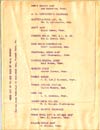
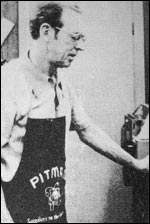 And he was a retired Linotype operator for the Tiller and Toiler in Larned.
And he was a retired Linotype operator for the Tiller and Toiler in Larned.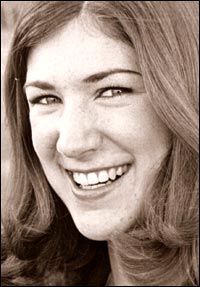 I met Bonnie in 1973, the year we were both in the
I met Bonnie in 1973, the year we were both in the 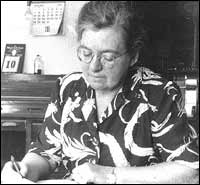 "I wanted to supplement my income and Joan asked Margaret Converse, the
postmaster, if Norm might need some assistance with filling out tax returns for
people during tax season. It so happened that Norm had been having trouble with
his eyes and was needing to do something about his business. Beside doing tax
work, he was an insurance agent, a notary, and worked as part-time clerk in the
post office. We met and he offered me his business as well as the clerk's job.
I decided to accept his offer.
"I wanted to supplement my income and Joan asked Margaret Converse, the
postmaster, if Norm might need some assistance with filling out tax returns for
people during tax season. It so happened that Norm had been having trouble with
his eyes and was needing to do something about his business. Beside doing tax
work, he was an insurance agent, a notary, and worked as part-time clerk in the
post office. We met and he offered me his business as well as the clerk's job.
I decided to accept his offer.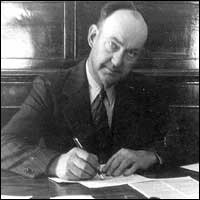 "Quite a few years earlier the area newspapers reported bear tracks and the
possible sighting of a black bear near the Pawnee Rock bridge. This caused a
stir among the residents since the river was a popular recreation area. One day
Norm took me down to the basement in the post office and showed me two blocks of
wood on the shelf. They had straps nailed on them and the bottoms carved in the
shape of bear paws. He and a friend, who had also made a pair, took them to the
river and strapped them on and created the tracks. It was quite a while before
the hoax was revealed and he had kept the blocks of wood as a proud memento of
their escapade.
"Quite a few years earlier the area newspapers reported bear tracks and the
possible sighting of a black bear near the Pawnee Rock bridge. This caused a
stir among the residents since the river was a popular recreation area. One day
Norm took me down to the basement in the post office and showed me two blocks of
wood on the shelf. They had straps nailed on them and the bottoms carved in the
shape of bear paws. He and a friend, who had also made a pair, took them to the
river and strapped them on and created the tracks. It was quite a while before
the hoax was revealed and he had kept the blocks of wood as a proud memento of
their escapade.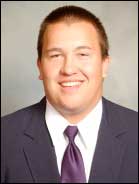 Belling the cat: It is with a great deal of pride that I point you all to No. 76, the offensive left guard for the Kansas State Wildcats football team. You don't know how long I've waited to see the name "Unruh" sewn on the back of a major college jersey.
Belling the cat: It is with a great deal of pride that I point you all to No. 76, the offensive left guard for the Kansas State Wildcats football team. You don't know how long I've waited to see the name "Unruh" sewn on the back of a major college jersey.